For an ancient Italian town perched on the edge of the Murgia National Park, Matera didn’t look promising when we drove into its unremarkable suburbs. But then came the historic centre and one of the most remarkable places I’ve been to anywhere in Europe…
We’d driven up from the modest airport on the industrial edge of Bari, having eventually mastered how to drive a big Citroen computer on wheels, through a scrubby, flat landscape, and along some awful pot-holed roads. Eventually the scrub gave way to a much more attractive vista of olive groves and fields of wheat, peppered with the trulli for which Puglia is famed.
But the start of our holiday in southern Italy saw us not in Puglia but in the neighbouring region of Basilicata, staying in its one-time capital. The grim suburbs and my disappointment disappeared rapidly as we drove into the narrow streets of the historic part of town. Ahead of us, the jumble of old Matera stood high on the edge of a wild gorge, carved by the Gravina that wound its way through the landscape. And what a sight it was.

This was the higgledy-piggledy district of the sassi, the ancient limestone cave dwellings that have been in use on and off for thousands of years by humans and their livestock. In fact, it’s thought that what we call Matera was one of the first human settlements in Italy.
Our hotel was amid this jumble of caves and the many buildings that have been bolted on to them over the centuries. The Locanda di San Martino isn’t so much a hotel as a collection of sassi, each of which has been turned into an elegant guest room linked by narrow alleys and steps. In our case, we got a bedroom with a very high barrel stone roof.
Arriving at lunchtime, we took time out to fill up on cold meats and cheeses in a touristy restaurant before going for a walk around town. Thunder accompanied us, rolling around the hills and valleys, and the sky turned a sullen dark grey.
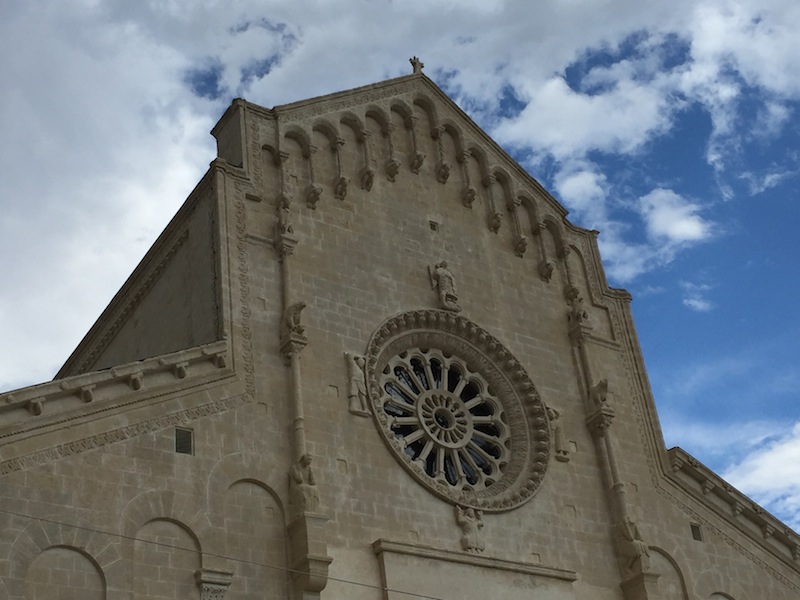
We climbed up several steep flights of steps to the 13th century Romanesque cathedral, past many empty buildings and caves, some just shells. Yet just yards away were those that have been converted into bars, homes, hotels and restaurants, representing the resurrection of old Matera.
The limestone cathedral that towers over the oldest part of the town stands in the Piazza del Duomo and has recently been restored. Plain enough on the outside, it’s a riot of baroque and gilding inside. More interesting are the ancient frescoes that were discovered beneath layers of marble and plaster on the walls, and the archaeological remains of an older church situated below the floor near the altar.
Back outside, we walked downhill towards the gorge. On the hills opposite we could see more caves – natural and man-made – that were doubtless once shelters for shepherds and farmers.
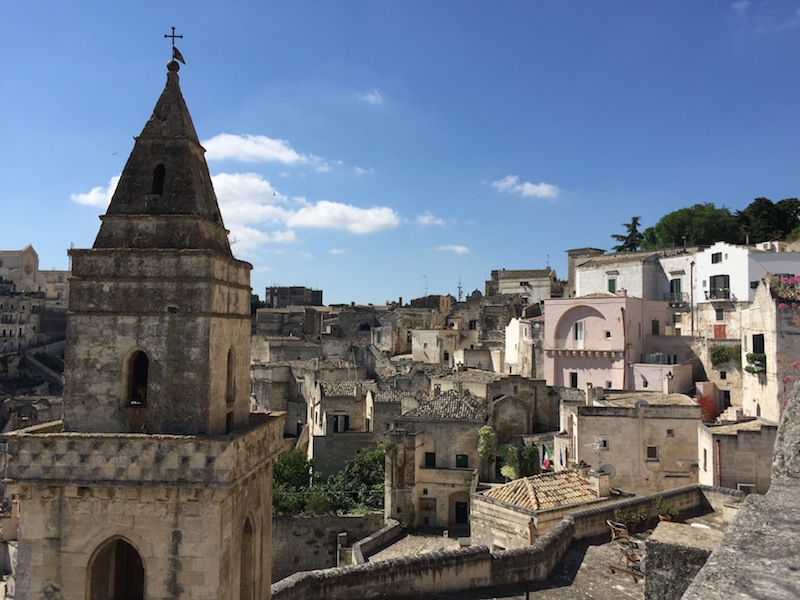
The storm that had been threatening broke over us, the rain turning the stone steps into waterfalls, so we hurried back to the centre. Drenched, we ran for cover and fortuitously found a wine bar.
In the evening and under clear skies we went up to the ‘newer’ part of town and watched thousands of sweeping and swerving swifts dancing above us. In the Piazza Vittorio Veneto were the townsfolk, promenading in that typically Italian way, so we stopped for a beer and watched the world go by. Handsome palazzo lined the streets, their backs to the grim sassi, giving a very different feel to Matera. We wandered along elegant streets lined with fancy shops and restaurants.
We ate at Il Fornello, which seemed to have the work experience team on for the night and where the service proved to be both slow, shambolic and unintentionally hilarious. Much more inviting was the friendly, youthful and bustling Birrificio 79 bar.

Beautiful blue skies greeted us the following morning so we stretched our legs through the Sasso Barrisano district close to the hotel. It’s the more commercial of Matera’s sassi districts but still charming and with plenty of caves and buildings jammed into the hillsides, many of them still empty. Up at Monastero di Sant Agostini we took advantage of the great views and it was there that Matera revealed itself in all its glory. Unique, breathtaking, spell-binding. I was running out of words to describe it but I could’ve stood there and consumed the scenery all morning.
We discovered the Chiesa di Madonna delle Virtù and Chiesa di San Nicola del Greci, a one-time church and monastery carved deep into the limestone hills and still boasting some of its ancient frescoes. The rooms where locals lived, worshipped, made wine and died would’ve been awfully gloomy but invitingly cool in the heat of summer. The amount of work that must’ve been involved in carving out all the rooms is beyond belief. We also learned that it was one of the locations around Matera where the dreaded Mel Gibson filmed The Passion of the Christ.
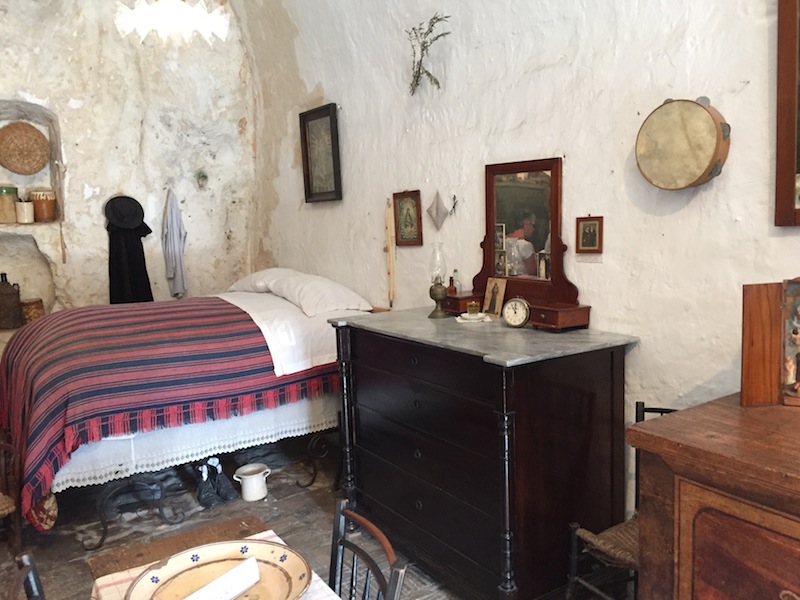
Continuing our walk around the edge of town, passing the fine San Pietro Caveoso church perched picturesquely on a rock overlooking the gorge, we went deeper into the Sasso Caveoso district, which has always had the reputation of being poorer than neighbouring Barrisano. Certainly, it seemed more remote and far less commercial. We stopped at the Casa Grotta di Vico Solitario, an old cave home that looks as it would’ve done when the residents were moved out back in the mid-1950s.
Essentially a cave, it looked quite quaint dressed up for tourists. But just a few short decades ago a large Italian family would’ve shared it with all their animals, and I couldn’t even begin to imagine what the heat and smell would’ve been like. Water was gathered from cisterns below the cave, which in turn were filled by rain water gathered by Matera’s ingenious system of channels and drains. The piss and shit was collected in chamber pots and slung out into the gorge.
Understand this and it’s easy to see why the caves became abominable places to live, condemned by many and to the shame of Italy. It’s why, as recently as the 1950s, that the Italian authorities were finally forced to move the locals out to new but perhaps equally depressing accommodation elsewhere.
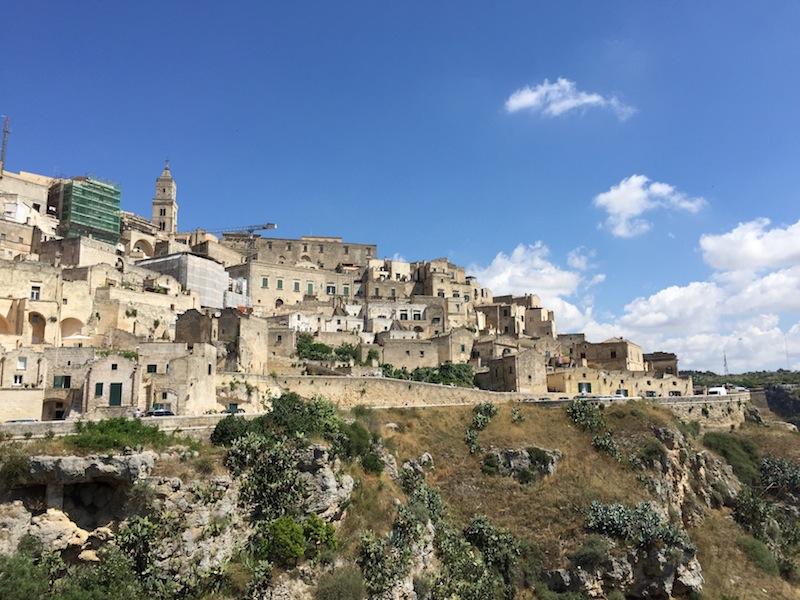
The sassi lay empty for many years. But in recent times, locals and those with a fondness for Matera have started bringing them back to life, proving that caves can be great places to live.
Soon we were back in the newer part of town again. Stopping at the Palazzo Lanfranchi, we found a busy community space and art gallery filled with grim religious paintings and statues as well as more modern works by local favourite Carlo Levi – the man who helped put Matera and its misery on the map after the war.
Lunch followed at Restaurant Nadi, where the service was ruthless and lacking any form of personality or charm. In the afternoon we wanted to explore the giant underground cisterns that helped store much of the town’s water supply in times past but they were closed. So we took a dip in the underground pool back at our hotel – a flooded cave bathed in moody blue light ideal for swimming and relaxing.
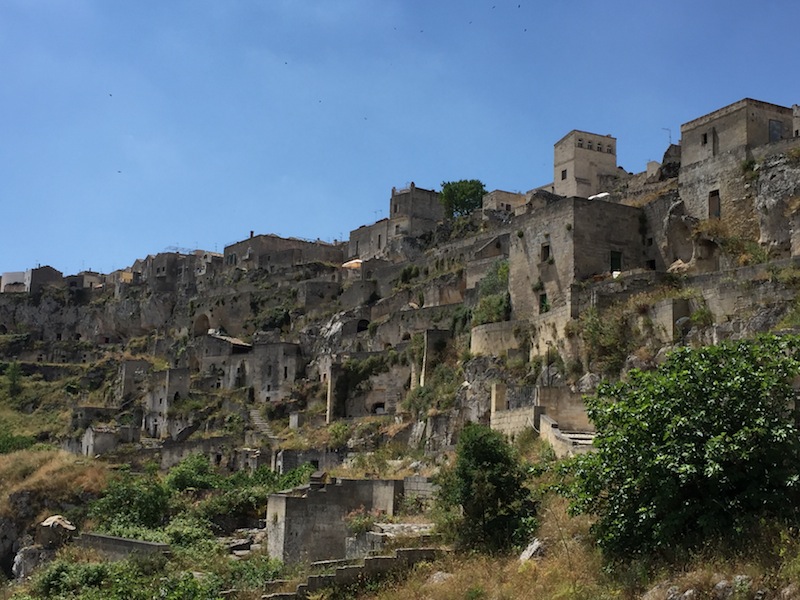
Our second and final night in Matera saw more storms and the town largely shut for a Monday night. But we ate and drank very well at La Gatta Buia and had a reasonably early night after failing to find a bar open.
As we drove away from Matera, I wondered about its future. Having been designated European City of Culture in 2019, its profile will only build in the coming years. That in turn will doubtless see more of the old sassi converted for locals and tourists. But how will that change its character?
For I found that it was, in part, the desolation of the district and the ghosts that haunt all those empty alleys and buildings that give the town its unique charm.

